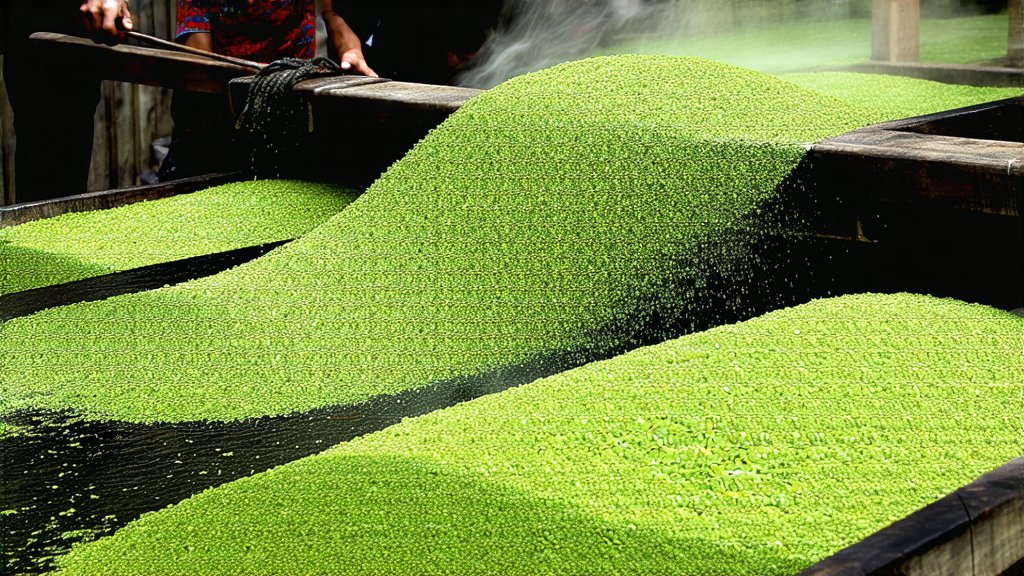
Huangshan Maofeng, a revered variety within the category of Chinese yellow teas, is a testament to the rich tapestry of Chinese tea culture that spans thousands of years. This article delves into the history, types, production techniques, and tasting methods of Huangshan Maofeng, offering an insight into this golden elixir that has captivated connoisseurs worldwide.
History of Huangshan Maofeng Yellow Tea
The history of Huangshan Maofeng is deeply rooted in the annals of Chinese tea cultivation. Originating from the Huangshan region in Anhui Province, this tea is named after the Maofeng peak of Huangshan, where the best leaves are traditionally harvested. The first records of Huangshan Maofeng date back to the Tang Dynasty, but it gained prominence during the Ming Dynasty when its unique yellowing process was perfected. Over the centuries, Huangshan Maofeng has been a symbol of luxury and refinement, often reserved for the imperial court and the elite.
Types of Huangshan Maofeng Yellow Tea
Huangshan Maofeng is categorized into several grades, each reflecting the quality and characteristics of the leaves. The highest grade, known as "Tribute Grade," is reserved for the most tender and delicate buds, while lower grades include "Imperial Grade" and "Special Grade." Each grade has its own set of criteria regarding the size, shape, and color of the tea leaves, ensuring a consistent and superior product.
Crafting the Perfect Cup of Huangshan Maofeng
The production of Huangshan Maofeng is a labor of love, requiring meticulous attention to detail and adherence to traditional methods. The process can be broken down into several key steps:
-
Picking: The leaves are handpicked from the tea bushes, with the best picking times being early spring and late autumn. The leaves are selected based on their size, color, and the stage of growth.
-
Withering: The freshly picked leaves are spread out to wither, allowing them to lose moisture gradually. This step is crucial for the development of the tea's aroma and flavor.
-
Kneading: The withered leaves are gently rolled and kneaded to break down the cell walls, releasing the natural juices and initiating the oxidation process.
-
Yellowing: This is the unique step that differentiates Huangshan Maofeng from other teas. The leaves are piled and covered, allowing them to undergo a controlled fermentation. This process gives the tea its characteristic yellow hue and mellow flavor.
-
Drying: The yellowed leaves are then dried to stop the fermentation process and lock in the flavor. This is done using traditional bamboo baskets over low heat, ensuring that the leaves are dried evenly.
-
Sorting and Packaging: Finally, the dried leaves are sorted by size and grade, then carefully packaged to preserve their freshness and aroma.
Tasting Huangshan Maofeng Yellow Tea
Tasting Huangshan Maofeng is an experience that engages all the senses. Here are some steps to guide you through the process:
-
Preparation: Use fresh, filtered water that is slightly cooler than boiling. The water temperature should be around 80°C (176°F) to avoid scalding the delicate leaves.
-
Steeping: Place a teaspoon of Huangshan Maofeng leaves in a teapot or a teacup. Pour the hot water over the leaves, allowing them to steep for 2-3 minutes.
-
Observation: As the tea steeps, observe the leaves unfurl and the water turn a pale yellow. The color should be clear and bright, indicating the quality of the tea.
-
Aroma: Inhale the aroma of the steeping tea. Huangshan Maofeng is known for its sweet, floral notes with a hint of chestnut, a result of the yellowing process.
-
Tasting: Take a sip and let the tea coat your palate. The flavor should be smooth and mellow, with a lingering sweetness that is both refreshing and comforting.
-
Multiple Infusions: Huangshan Maofeng can be infused multiple times, with each infusion revealing different nuances of the tea's flavor profile. Enjoy the evolution of taste as the tea unfolds with each steeping.
Conclusion
Huangshan Maofeng Yellow Tea is more than just a beverage; it is a journey through the heart of Chinese tea culture. Its history, production, and tasting experience offer a glimpse into the artisanal practices and the depth of flavor that have made it a cherished part of the Chinese tea tradition.